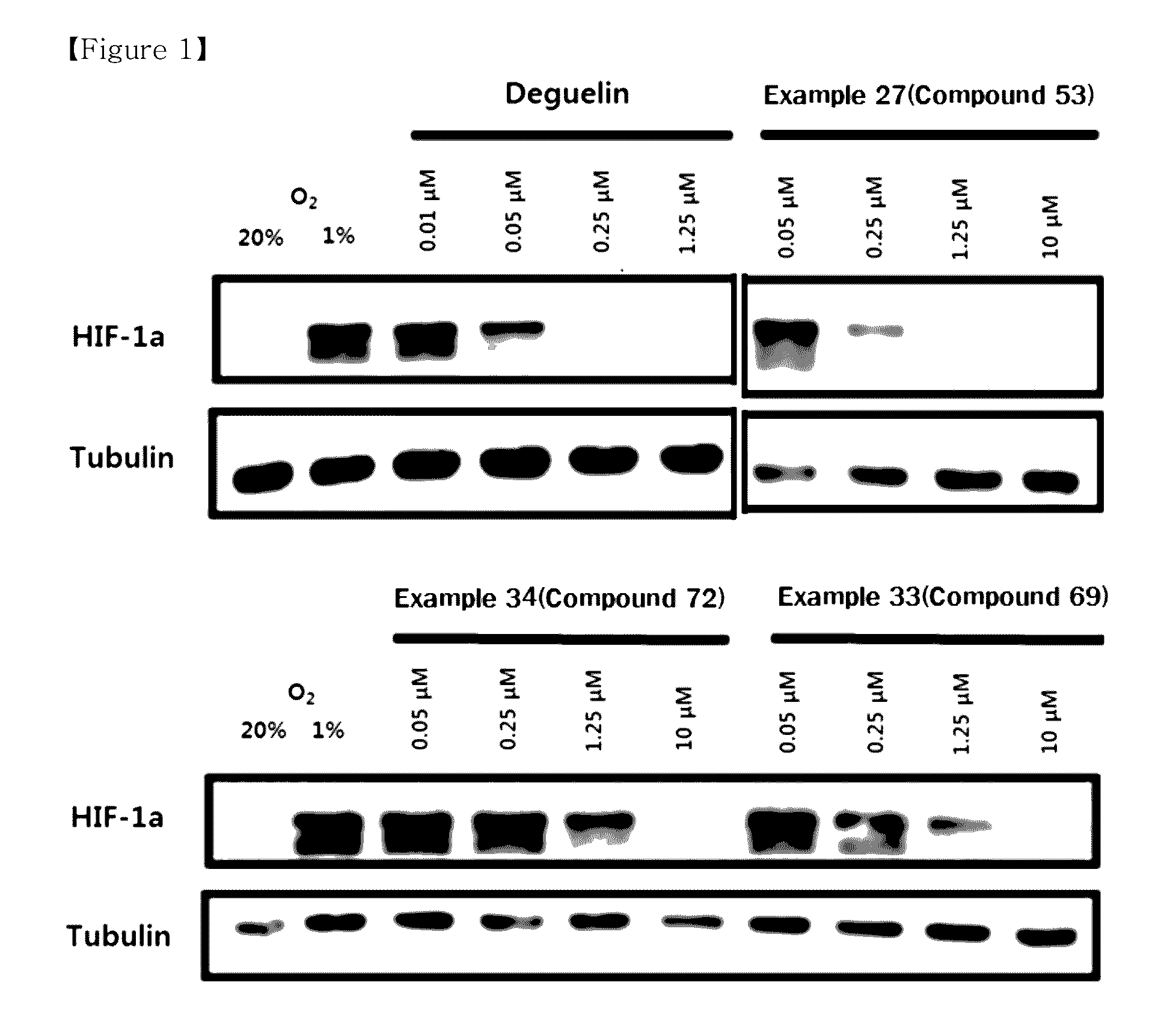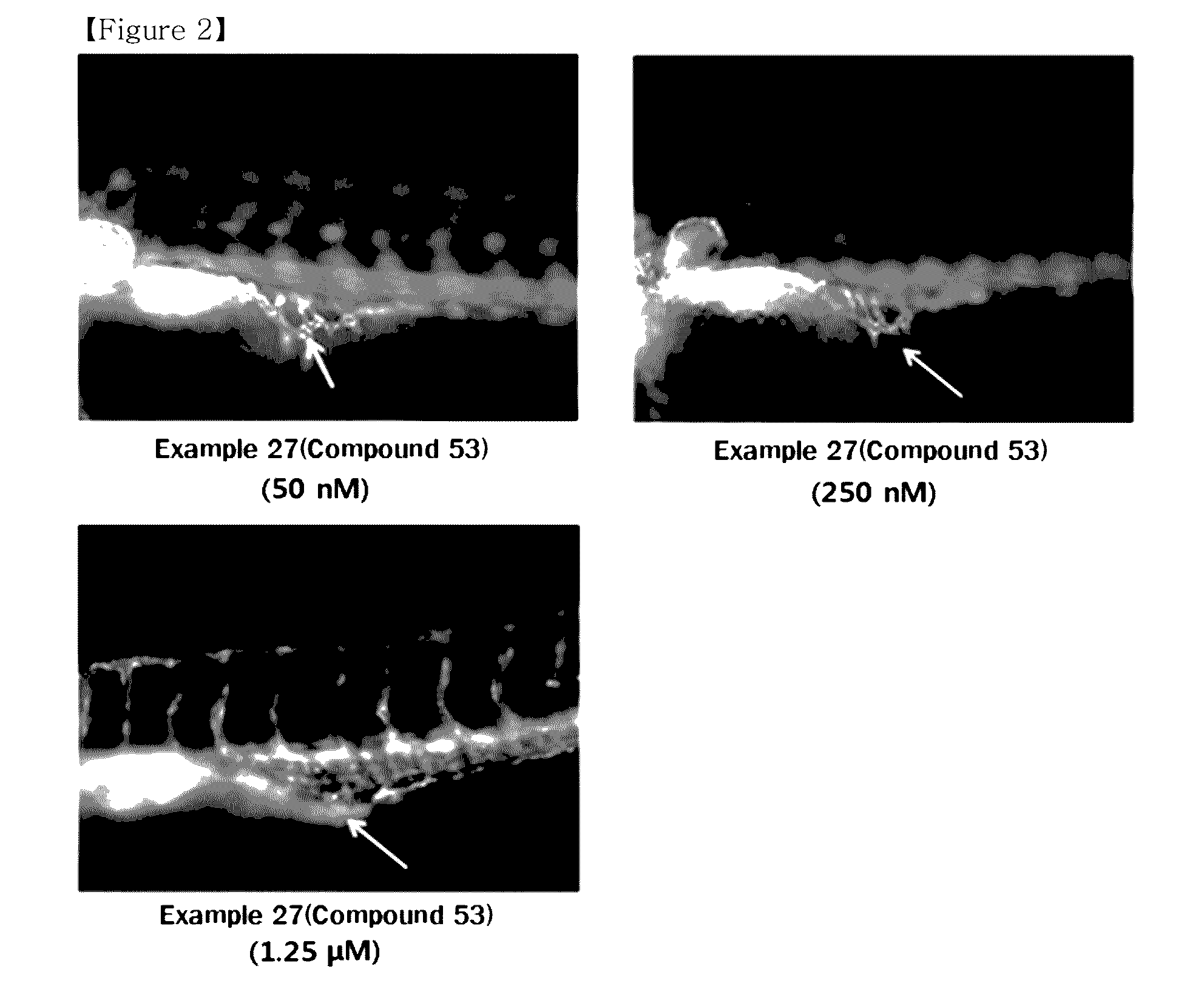Novel compound or pharmaceutically acceptable salt thereof, and pharmaceutical composition containing same as active ingredient
a technology of compound and active ingredient, which is applied in the field of compound inhibiting hsp90, can solve the problems of draw a limit in the use of deguelin as a drug, and achieve the effects of reducing the expression of hsp90, low toxicity, and efficient inhibition of vegf activation
- Summary
- Abstract
- Description
- Claims
- Application Information
AI Technical Summary
Benefits of technology
Problems solved by technology
Method used
Image
Examples
manufacturing example 5
Preparation of (S)-2-(3,4-Dimethoxyphenyl)-3-hydroxy-1-(5-hydroxy-2,2-dimethyl-2H-chromen-6-yl)propan-1-one (36)
[0243]
[0244]The compound 35 (23 mg, 0.044 mmol) prepared in Manufacturing Example 4 and CH2Cl2 (1.0 mL) were loaded in a 10 mL round-bottom flask, which was dried by heating. The mixture was cooled down to −78° C., to which boron trichloride (0.16 mL, 0.16 mmol, 1.0 M in CH2Cl2 solution) was added. After stirred for 1 hour, the reaction was terminated with saturated NH4Cl aqueous solution. Then, the reaction mixture was extracted with CH2Cl2, dried over MgSO4, and concentrated under reduced pressure. The residue was purified by flash column chromatography (EtOAc:n-hexane=1:2) to give the compound 36 of Manufacturing Example 5 as a light-yellow solid (yield: 75%, 12 mg).
[0245]1H NMR (CDCl3, 300 MHz) δ 7.40 (d, 1H, J=8.7 Hz), 6.76 (m, 3H), 6.53 (d, 1H, J=11.1 Hz), 6.49 (d, 1H, J=10.5 Hz), 5.63 (d, 1H, J=9.9 Hz), 4.75 (dd, 1H, J=8.7, 4.8 Hz), 3.81 (s, 3H), 3.80 (s, 3H), 3.77 ...
manufacturing example 6
Preparation of methyl 2-(2-bromo-4,5-dimethoxyphenyl)acetate (38)
[0246]
[0247]N-bromosuccinimide (449 mg, 2.50 mmol) was added to anhydrous THF (12.0 mL) solution containing the compound 32 (500 mg, 2.38 mmol) prepared in Manufacturing Example 1. The reaction mixture was stirred at −78° C. for 30 minutes. After raising the reaction temperature to room temperature, the mixture was filtered and concentrated under reduced pressure. The obtained residue was purified by flash column chromatography (EtOAc:n-hexane=1:3) to give the compound 38 of Manufacturing Example 6 as a light-yellow solid (yield: 96%, 660 mg).
[0248]1H NMR (CDCl3, 300 MHz) δ 6.96 (s, 1H), 6.72 (s, 1H), 3.79 (s, 6H), 3.66 (s, 2H), 3.65 (s, 3H).
manufacturing example 7
Preparation of methyl 2-(2-bromo-4,5-dimethoxyphenyl)pent-4-enoate (39)
[0249]
[0250]The compound 38 (150 mg, 0.52 mmol) obtained in Manufacturing Example 6 was dissolved in anhydrous THF (6.0 mL) at −78° C., to which LHMDS (0.63 mL, 0.93 mmol, 1.0 M in THF solution) was added drop by drop. After stirred for 20 minutes, the mixture was added with aryl bromide (0.044 mL, 0.52 mmol) drop by drop, followed by stirring again for 1 hour with raising the temperature to −40° C. The mixture was treated with saturated NH4Cl aqueous solution (5.0 mL), to which water (5.0 mL) was added. The water layer was extracted with EtOAc (2×15 mL) and the organic layer was dried over MgSO4, filtered, and concentrated under reduced pressure. The obtained residue was purified by flash column chromatography (EtOAc:n-hexane=1:8) to give the compound 39 of Manufacturing Example 7 (yield: 53%, 90 mg).
[0251]1H NMR (CDCl3, 300 MHz) δ 6.94 (s, 1H), 6.81 (s, 1H), 5.68 (m, 1H), 4.98 (m, 2H), 4.11 (dd, 1H, J=8.2, 7.2 ...
PUM
 Login to View More
Login to View More Abstract
Description
Claims
Application Information
 Login to View More
Login to View More - R&D
- Intellectual Property
- Life Sciences
- Materials
- Tech Scout
- Unparalleled Data Quality
- Higher Quality Content
- 60% Fewer Hallucinations
Browse by: Latest US Patents, China's latest patents, Technical Efficacy Thesaurus, Application Domain, Technology Topic, Popular Technical Reports.
© 2025 PatSnap. All rights reserved.Legal|Privacy policy|Modern Slavery Act Transparency Statement|Sitemap|About US| Contact US: help@patsnap.com



